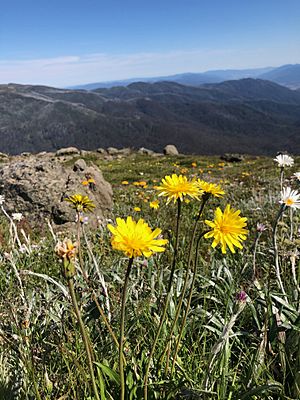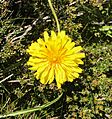Microseris lanceolata facts for kids
Quick facts for kids Microseris lanceolata |
|
|---|---|
 |
|
| Scientific classification | |
| Kingdom: | |
| (unranked): | |
| (unranked): | |
| (unranked): | |
| Order: | |
| Family: | |
| Subfamily: |
Cichorioideae
|
| Tribe: |
Cichorieae
|
| Genus: |
Microseris
|
| Species: |
M. lanceolata
|
| Binomial name | |
| Microseris lanceolata (Walp.) Sch.Bip.
|
|
| Synonyms | |
|
|
Microseris lanceolata is a type of plant found in the mountains of Australia. It has bright yellow flowers. This plant is one of three kinds of "yam daisy" or "murnong." The other two are Microseris scapigera and Microseris walteri.
You can find Microseris lanceolata in southern Australia. This includes places like Victoria, New South Wales, and the Australian Capital Territory. In Victoria, it mostly grows in high mountain areas.
What's in a Name?
For many years, these murnong plants were sometimes called Microseris sp., Microseris lanceolata, or Microseris scapigera. A botanist named Neville Walsh helped clear up the names in 2016. He explained the differences between the three types of Microseris plants.
Here are some ways to tell them apart:
- Roots: M. walteri has one main root that forms a tuber (a round, fleshy part). M. lanceolata has several roots that branch out. M. scapigera also has several roots that branch.
- Flowers: The flowers of M. walteri and M. lanceolata are usually larger than 15mm. M. scapigera flowers are smaller, up to 12mm.
- Taste: The roots of M. walteri are sweet and good to eat. M. lanceolata roots taste bitter. M. scapigera roots are a little bitter but okay to eat.
Plant Description
Microseris lanceolata grows in a bunch of leaves that look like a rosette. The leaves are long and have small teeth along their edges.
Its yellow flowers look a bit like dandelions. In its mountain home, the flowers start to bloom in December. This happens when the weather gets warmer, around 20 degrees Celsius. Before blooming, the flower stalk hangs down. Then it stands up straight to attract insects that help pollinate it. After flowering, the seeds ripen. They form a fluffy ball, like a dandelion clock. Each seed has fine hairs that help it fly away in the wind.
This plant has several fleshy roots. They branch out just below the ground. This is different from Microseris walteri, which has a single tuber root.
How People Use It
The roots of murnong plants were a very important food for some Aboriginal Australian people. However, the descriptions of these edible roots usually refer to Microseris walteri, which has sweet-tasting tubers. Sometimes, plant nurseries might accidentally sell Microseris scapigera plants labeled as Microseris lanceolata.
Images for kids





